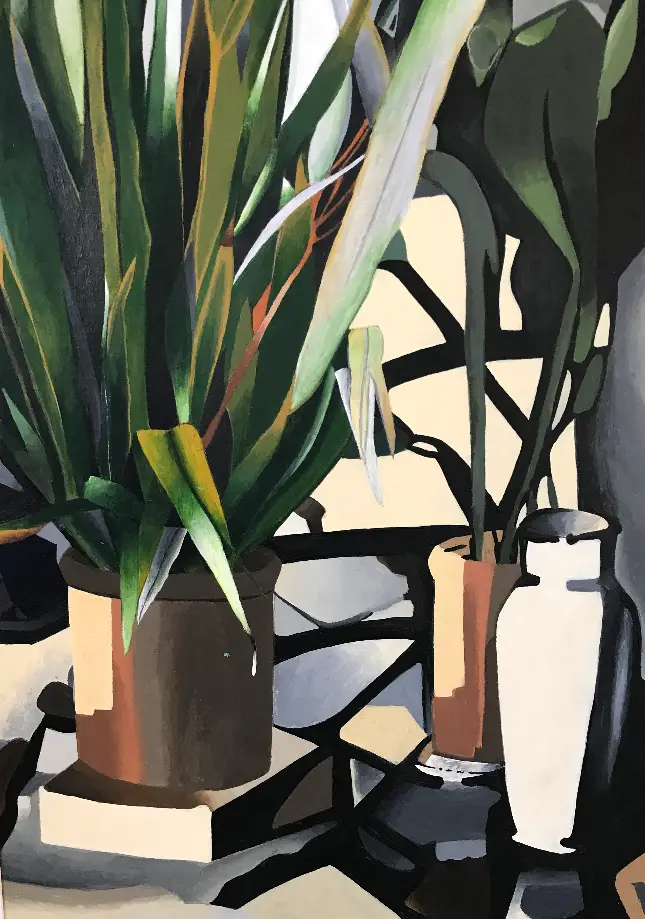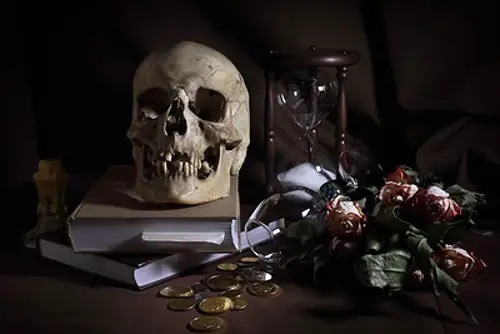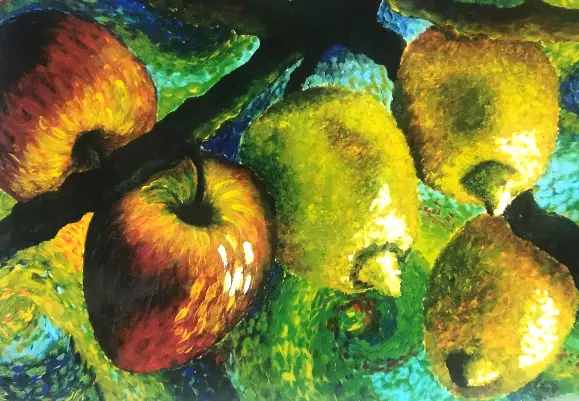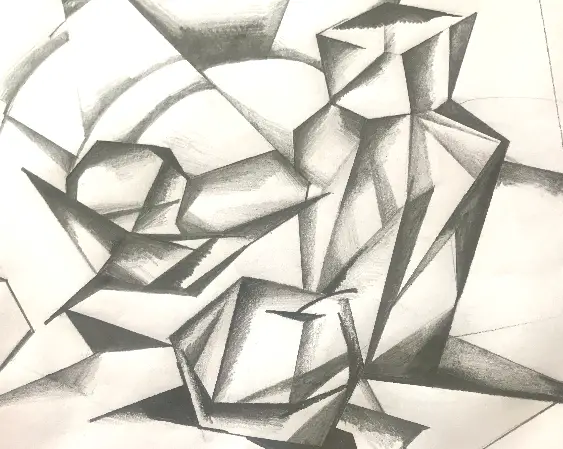It is called a still life because it contrasts figure drawing that uses a live human model. Still Life art uses objects that never move, and artists can practice for hours with the material until they get better at it. The artist can place the subject anywhere they prefer. On top of the table, on a chair, on the floor, or even on top of the bed.
Still Life painting or drawing is commonly used by an art novice to get better at drawing or painting with everyday practice.
What is Still Life Drawing?
Still Life is a type of painting or drawing where the subjects are all inanimate. It can be objects such as flowers, fruits, glassware, bottles, crockery, vases, keys, bowl, cutleries, and more. Still Life is a well-known genre because the artist controls the subject and can place the inanimate object wherever they want and have it in the same position. It makes practicing easy, particularly for art practitioners.
Learners can study shape and form and also learn about handling different mediums while doing Still Life art.
Please look at this drawing and sketching video course I have created. Use this link.
History of Still Life
It was in the 16th and 17th centuries that this art form became popular. Also, the work of Jan Brueghel, Pieter Clausz, among others, became well known when they painted stunning and realistic images of bouquets and a table filled with bowls of game and fruit. But the first major Still Life was from Jacopo de’Barbari in 1504.
Over a thousand years ago, the Ancient Egyptians painted temples and tombs with offerings for the gods such as bread, duck, grapes, cucumber, and several types of meat. Egyptians during that time make a graphic representation of their subjects, which is common in Egyptian painting.
Related Posts:
Genres Explained: Still Life in Painting and Drawing:
16th Century Realism
The luxury of the rich is the subject of these paintings and is considered a status symbol. The possessions seen in the painting are owned by the person who requested the Still Life painting.
Vanitas
Vanitas still life depicts the reality of death that is depicted cause the skull represents the owner's death. That even with all worldly possessions, all will be useless once you passed away. This Still Life originated from Holland.
Fauvism
It was a popular style in the 19th century, and unlike the previous form of Still Life, this one was painted with bold and bright colors that evoke cheerful feelings.
Cubism
Cubism became popular in the 20th century. It is a depiction of the world that is from an abstract scene that lets the viewer see Life differently.
Pop
It is the newer style using bright colors and bold lines to create pop art. They likened it to a comic book. The first well-known pop artist in the world is Andy Warhol.
What is the Purpose of Still Life?
Various objects have different meanings, and with the use of still life compositionss or drawing, they afford viewers a different perspective. Some are even symbolic, while they depict other subjects with exuberance, beauty, and Life.
Develops the Foundation of Drawing Skills
Drawing what you see and putting it on paper as you depict it is the best way to develop your skills. It does not just see and simply drawing, but you also must observe the different facets of the subject, such as the color, the shape, outline, scaling, shading, and texture.
Help an Artist Get Better at Observing the Details That Matter
By not observing and appreciating the minor details, you cannot transfer what you see on paper in the best way. You must learn how to look at the object with more attention and capture the details. It will help you make the best depiction of your subject.
Improves Drawing Skills From Memory
When you have practiced still life drawing, and you get better at it, soon you can draw different objects from memory. You can create a replica of the subject you have in mind and apply even the smallest details.
Provides Endless Subjects For Painting or Drawing
You need not go out and find inspiration or subjects to draw cause there will surely be items inside your home that you can use for your Still Life drawing. This makes it convenient for any artists cause they use whatever is on hand, like a cup of coffee, pieces of jewelry, lamps, tables, keys, plants. Even a book can be a subject for still life drawing.
Helps an Artist Control the Lighting During the Process
It is easy to change the lighting according to preference when drawing Still Life, especially indoors. If you are not drawing during the daytime, you can use a lamp or other lighting effects to show the different angles and include the shadows.
Beginners will appreciate controlled lighting as they can change the angle depending on the light use or the lack of it.
Who Invented Still Lifes?
There were many famous Still Life painters in the old days, but it was Jacopo de’Barbari (Jakob Walch) who paved the way for this type of drawing to be out in the world and for it to be popular.
Jakob was a known engraver and painter and, in 1504, painted the first pure Still-Life masterpiece. He was a court painter during his stay in Wittenberg and Nuremberg.
What does the Term Still Life Mean?
It is a work of art where the subject matter comprises inanimate objects commonly found around us. It can be food, glasses, books, vases, games, plants, coins, rocks, shells, and so much more.
Subject Matter Still Life
The objects that artists use for their Still Life paintings comprise Still Life objects. It can be man-made or natural objects. Below are samples of subjects used in still life painting.
- Bowl of Fruit
- Wine
- Flowers
- Bag
- Jewelry
- Apple
- Grapes
- Vegetables
- Cut flowers
- Glass
- Musical Instruments
- Jars
- Table
- Vase
- Dead birds
Still Life Paintings
There are many subjects one can start with, which is the advantage of Still Life composition. Subjects can be simple such as a box, vase, shoe, egg, among others.
It is also a fantastic practice if you want to test yourself and your skills in painting. There is no pressure, particularly for novices, and there is no rush to have a stunning result. One can test their Still Life drawing skills by practicing and improving along the way.
Famous Still Life Artists:
Still Life Painting of Vincent Van Gogh
One of the many styles of Van Gogh is in painting Still Life. He creates vibrant paintings out of subjects that are otherwise dull or boring. Because of his expertise, he came up with stunning and unique art pieces.
Paul Cezanne
Cézanne used his expertise in shapes and composition to make Still Life images that are beautiful, although not as vibrant as the painting of Van Gogh. Paul Cézanne painting is a league of its own.
Caravaggio
Caravaggio painted _Basket of Fruit_, a Still Life painting he made in 1599. He applied high contrasting colors and black tones. The dark color provides a high value to the Still Life painting and made it one of his well-known masterworks.
Jan Bruegel
Another famous artist in the Still Life genre specialized in floral subjects and landscapes. His work titled Flowers in a Wooden Vessel also displays several types of flowers and makes sure that each flower has the finest details.
Frans Snyders
He was a pioneer of Flemish Baroque art and specialized in Still Life during this period. His subject ranges from animal, market scenes, and hunting. His favorite subjects are birds, dogs, monkeys, poultry, and more.
Claude Monet
Monet’s still life painting always lean to landscape for his subject. He also used a colorful palette, often playing with dark and light hues, to balance his masterpiece.
Jean- Baptise- Simeon Chardin
Chardin prefers using dark surroundings in his work, and placing lighting is well-thought-of with his every painting. His work, The Ray in 1728, depicts the cat, fish, bottles, and a ray.
Still Life on a Tabletop
A Still Life, where the inanimate objects and subject matters are arranged on a tabletop. One can experiment with the lighting, compositions, and arrangement until the artist is at ease to start the painting, drawing, or even to take a photograph of the objects.
To make your still life masterpiece successful, one must make the arrangement more interesting, add lighting and choose the ideal location.
Subjects are also small objects, and the artist can choose from the hundreds of inanimate objects around him.
Academic Still Life
It was in 1648 when the French Royal Academy of Art was founded in Paris. Here, French artists were trained uniformly and under distinguished circumstances.
Art masterpiece presented by artists was viewed regularly by the public.
In this history, Still Life was referred to as the least significant category compared to copying instead of intellectual art.
Until the themes in painting changed towards great technique, focusing on simplicity and finding a simple subject matter. It was also during this time when Chardin, another artist who was accepted in the Academy in 1728, became well known for his minimalist style by capturing the essence of his subjects instead of copying the details of his materials.
One of his famous works was _The Attributes of the Arts and their Rewards_, made in 1766. The painting was a tribute to his friend and sculptor, Pigalle.
During his stay in the Academy, he also influenced many painters, including Anne Vallayer-Coster whose work captured the attention of Marie-Antoinette and became a royal court painter making her one of the talented women-painter who has made a niche and found success. Coster’s work includes _Still-Life with Tuft of Marine Plants, Shells, and Corals_ in 1769.
Renaissance Still Life
Still life painting in the Renaissance period focuses on religious symbolism and contains allegorical meaning. Still life works would include symbols and other elements in the background of paintings.
It is obvious in the still life work of Jan van Eyck, a Flemish painter whose paintings are popular because they clearly represent something and have a meaning behind each masterpiece.
But with Leonardo da Vinci and Albrecht Dürer's work, a German painter, there is no religious symbolism but focuses on subjects like flora and fauna. Here, the meaning of Still Life compositions was followed closely, which is observing what you see and painting it.
The Northern Renaissance period focuses on rapid development in oil painting while the subject still includes religion. Their Still Life objects are not decadent and obscure but earthy or subtle. But the subject matters changed and depicted landscapes later on.
Modern Still Life
It was during the art movements of Impressionism and Post-Impressionism that the modern still Life predominated, and it was _Vincent van Gogh_ who brought to Life a more extreme expression of abstract flowers and paintings of a vase.
PAUL CÉZANNE, a French artist also from the Post-Impressionism, painted Still Life with subjects including fruit, bread, basket on top of a table, bottles, all beautifully displayed. His work, _The Basket of Apples,_ in 1895 was one of the admired Still Life paintings in that era. Cézanne used colors and brushstrokes differently as he portrays what he sees in such a stunning and realistic perspective without the symbolic meaning behind the painting. Another work of Cézanne titled _Still Life with Skull _was painted between 1895 to 1900.
Famous Still Life Artists in the 20th Century:
* ROY LICHTENSTEIN became famous for his use of pop art. His use of dots and comic book style makes him one of the prominent artists for Still Life in modern times.
* GEORGIA O’KEEFFE is regarded as the mother of American Modernism. She was known for painting subjects of landscapes, flowers, skulls, fruit, and dead rabbits.
* MAYA KOPITSEVA focuses on using objects like fruits, dishes, and other objects one can easily find in the kitchen. She creates Still Life with impressive colors and provides enough contrast to her every subject.
* JUDY CHICAGO made one of the most significant works of the 20th century Still Life art titled Dinner Party. The painting depicted the table setting for 39 famous women and serves as an eye-opener not to omit women in history.
Cubists
One of the popular artists who have created a Still Life art using the abstract and cubist style is Pablo Picasso and Georges Braque. Pablo’s masterpiece, titled _Large Still Life_, which was painted between 1881 to 1973, has caught the attention of many people because of the beautiful art that evokes extraordinary feelings from the viewer.
Pablo Picasso and Georges Braque created _Still Life with Metronome_ in 1909 has the same effect, showing how he depicted his unique style by painting a great subject matter. Another painting he did was _Pitcher and Violin_ between 1909 – 1910.
Dutch and Femish Still Life
Still life art during this time was prominent. It was a genre that started in the Netherlands, and the subject involves flowers and less religious artworks.
Still life painting was highly favored because of the availability of subjects, from the things you see every day and other objects that people use in their daily existence and which later on was coined as “Dutch Realism.”
Dutch artists also incorporate imports of high values in their painting and include foreign commodities. It makes the Still Life drawing more lavish and filled with intricate subjects that depict the affluence of the Netherlands that they enjoyed from trade.
The most common Dutch and Flemish Still Life paintings include the _Vanitas genre, Ontbijtjes (breakfast pieces), Pronkstilleven (ornate), and florals. _
To get a sample from the mentioned subjects above, one painter named Clara Peeters made a Still Life composition using cherries, artichoke, milk, and even cheese. Her work evokes a nationalistic feeling as the subjects are almost like heritage and came from Dutch agriculture. The painting signifies many things, such as the biscuit symbolizing the daily Life that evolves, and the cherries, butter, artichoke reminds viewers that the only constant thing in life is change.
Some Samples of Dutch Still Life Paintings as Below:
* _”Still Life with Cheeses, Artichoke and Cherries”_ painted by Clara Peeters in 1625
* _”Banquet Pieces, Mince Pie”,_ by Willem Claesz Heda, 1635
* _”Still Life Lobster and Fruit_” by Abraham van Beyeren, 1650
* _”Still Life with a Chinese Bowl”_, a Nautilus Cup and Fruit by Willem Kalf, 1662
* _”Still Life with Moor and Porcelain Vessels”_ by Juriaen van Streeck, 1670
Tips When You Want to Draw a Still Life :
If you want to enhance your drawing skills and start with Still Life drawing, here are steps to help you have a great start.
Find Your Subject
Anything that catches your attention can be your subject. It doesn't have to be a fruit, a flower, or a plant as long as it is an inanimate or non-living object. It can be a shoe, a faucet, a bowl, or a box that can be your subject. If you don’t want to stay inside to look for inspiration for your drawing, you can also check outside cause you will see endless materials for your subject.
A fence, a fallen branch, the lamppost, a bird’s feather, and more. Always choose a subject that inspires you to capture its essence and not randomly sketch to have something to draw. The viewers can see how inspired you are with your drawing or how uninspired as well.
Arrange Your Subject
If you are an artist and have an eye for beauty, you will know how to arrange your subject. A fallen leaf will look better when at a certain angle, catching colors and lighting. You can also shade well when you have your subject in the right position. Also, finding the accurate title for your drawing requires a good eye on what you are drawing and what you want to convey to your viewers.
Angles and lighting will have an impressive effect on your piece, and you should always look at your drawing from your viewer’s perspective and what you want them to see. Lighting will have a crucial effect on your Still Life drawing and one you should use smartly.
Make sure that your arrangement is making sense and will not look chaotic. Ensure a balanced and calm use of space as well with your drawing.
Take a Moment
When you already have a subject, you can also visualize what outcome you want with your drawing. That is how you can arrange it correctly, and that is how you can also place the lightings and put them at the right angle.
Take the time to study your subject and see the perspective, find out where the shadows fall and how the light reflects from the object.
Do not immediately draw without thinking and studying your subject. You can see details immediately if you know how to observe, and it is what you will also put on paper and improve as you go along.
Draw and Sketch the Form of Your Subject
Placing shapes and basic outlines on your subject is how you start. It is like imagining the frame and then putting them on paper. After you have the wireframe, you can place the required details and surface area.
Begin Applying Shading to Your Drawing
Find out where to place the noticeable shadows. Here you can use hatching or smudging to make it more prominent. Place some light shadows, and add more later on. Check the shapes if it is adapting to the shadow and if there are no details out of line.
Perfect the Details
This is where you will correct the lines and adapt the shading style and intensity of the edges. Smoothen out the edges if required. The details you should include will matter cause they will provide the correct features of the object you are aiming for. Wood should have the look of wood, metal with metal, and so on.
You may run into trouble with the shading and placing the correct details at first, but this is where you will apply practice since you will need to have experience with doing Still Life drawing. You also find that some materials or subject is not as easy to handle and you need to make some adjustment with your style and identify what will work for you.
Create Art With My Favourite Drawing Resources
General Drawing Courses. I like Udemy if you want to develop your knowledge of drawing techniques. Udemy is an excellent choice due to its wide range of creative courses and excellent refund policy. They often have monthly discounts for new customers, which you can check here. Use my link.
Sketching and Collage. Take a look at this sketching resource I have created. Use this link.
Proko. Is one of my favorite teachers who surpasses in the teaching of Anatomy and Figure drawing. Prokos course breaks down the drawing of the human body into easy-to-follow components aiding the beginner to make rapid progress. For this, I really like Proko.
Art Easels. One of my favorite ways to draw is by using a drawing easel, which develops the skill of drawing on a vertical surface. The H frame easel is an excellent vertical way to add variety to the style and type of marks you create when using a drawing board.
To see all of my most up-to-date recommendations, check out this resource I made for you.





